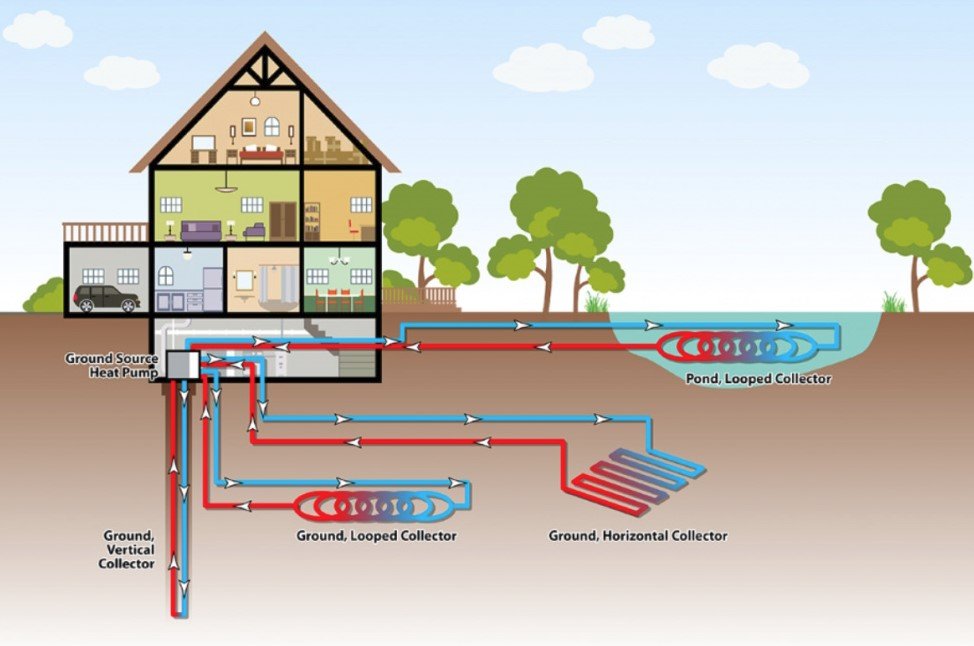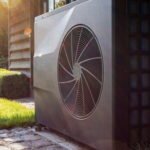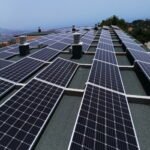 At Solares Energies, we are committed to delivering top-notch ground source heat pump systems, leading the way in sustainable and efficient home heating in Spain. Our dedication to quality, innovation, and customer satisfaction has made us the #1 choice for homeowners and businesses alike seeking eco-friendly heating solutions. If you’re looking for the best ground source heat pumps the Costa del Sol has to offer, look no further! We’re well placed to support southern Spain with our offices in both Marbella, Malaga, and Pueblo Nuevo, near Sotogrande in Cadiz.
At Solares Energies, we are committed to delivering top-notch ground source heat pump systems, leading the way in sustainable and efficient home heating in Spain. Our dedication to quality, innovation, and customer satisfaction has made us the #1 choice for homeowners and businesses alike seeking eco-friendly heating solutions. If you’re looking for the best ground source heat pumps the Costa del Sol has to offer, look no further! We’re well placed to support southern Spain with our offices in both Marbella, Malaga, and Pueblo Nuevo, near Sotogrande in Cadiz.
 Our Ground Source Heat Pumps represent the pinnacle of heating technology, offering a harmonious blend of efficiency, reliability, and environmental stewardship. By harnessing the stable temperatures of the earth, these systems provide consistent and cost-effective heating and cooling all year round, drastically reducing your carbon footprint and energy bills.
Our Ground Source Heat Pumps represent the pinnacle of heating technology, offering a harmonious blend of efficiency, reliability, and environmental stewardship. By harnessing the stable temperatures of the earth, these systems provide consistent and cost-effective heating and cooling all year round, drastically reducing your carbon footprint and energy bills.
We understand that every property is unique. That’s why our team of experts works closely with you to design and install a system that perfectly fits your specific requirements. Whether you’re upgrading an existing property or building a new one, we ensure a seamless integration of our ground source heat pumps into your space.
At Solares Energies, quality is not just a promise; it’s our standard. We partner with leading manufacturers to bring you the most durable and efficient systems on the market. Our skilled technicians are trained to the highest standards, ensuring flawless installation and maintenance services.
Join us in our mission to create a greener, more sustainable future. Embrace the change with Solares Energies, where innovation meets sustainability. Explore our range of ground-source heat pumps and find out how we can help you transition to a more energy-efficient and environmentally friendly way of living.
 Are you ready to step into the future of home comfort with Solares Energies? Our Ground Source Heat Pumps (GHPs) are not just products; they are gateways to a sustainable, energy-efficient lifestyle. As pioneers in harnessing the earth’s constant temperature, we offer you an unparalleled opportunity to reduce your carbon footprint and energy bills simultaneously.
Are you ready to step into the future of home comfort with Solares Energies? Our Ground Source Heat Pumps (GHPs) are not just products; they are gateways to a sustainable, energy-efficient lifestyle. As pioneers in harnessing the earth’s constant temperature, we offer you an unparalleled opportunity to reduce your carbon footprint and energy bills simultaneously.
Imagine a heating and cooling system that adapts to the seasons, providing warmth in winter and coolness in summer, all while saving you money. That’s the promise of Solares Energies’ GHPs. With the earth’s steady underground temperature as our ally, these systems are a marvel of efficiency and reliability.
 Bid farewell to noisy, high-maintenance heating systems. Our ground source heat pumps are the epitome of tranquillity and longevity. They are discreet, require minimal upkeep, and are designed to blend seamlessly into your lifestyle.
Bid farewell to noisy, high-maintenance heating systems. Our ground source heat pumps are the epitome of tranquillity and longevity. They are discreet, require minimal upkeep, and are designed to blend seamlessly into your lifestyle.
The initial investment in our GHP system might seem significant, but it’s an investment in your future. With potential energy savings returning the cost in as little as 5-10 years, and a system life that spans decades, this is one decision you’ll thank yourself for, year after year.
Every home is unique, and so are our solutions. Whether it’s the cost-effective horizontal loops for spacious properties, the space-saving vertical loops for urban homes, or the innovative pond/lake systems for those with water bodies nearby, we have something for everyone.
Heat Pump Systems: Ground Source Heat Pumps (GSHPs) are more than just heating systems; they are a commitment to eco-friendly living and long-term financial savings. With Solares Energies, you can expect an initial investment for a GSHP installation to range between €18,000 and €50,000.
This range reflects various factors such as system size, property requirements, and installation complexity. While this may seem substantial, it’s a transformative investment for your property, backed by attractive government grants.
The cost of a GSHP is comprised of two main components: the price of the equipment, which accounts for about 50% of the total cost, and the installation expenses. The most significant portion of installation costs arises from the groundwork or drilling needed to lay the heat exchange pipework.
At Solares Energies, we understand that every home is unique. That’s why we offer two types of GSHPs: vertical and horizontal ground source heat pumps, each tailored to different spatial and geological conditions. Vertical systems, requiring deeper boreholes, are ideal for properties with limited outdoor space. Conversely, horizontal systems are more cost-effective and suited for properties with more land available.
Ground Source Heat Pumps: Require deeper boreholes, costing approximately €60 – €80 per metre to dig, with an average total of around €15,000 for a typical 12kW system.
Horizontal Ground Source Heat Pumps: More affordable due to shallower borehole requirements, with overall costs ranging from €18,000 to €44,000.
At Solares Energies, we’re committed to providing tailored, efficient, and eco-friendly heating solutions. Contact us today to explore how a ground source heat pump can revolutionise your home’s heating, and for a personalised quote that ensures you’re getting the best value for your investment.
What’s the best type of heat pump for me? – If you are interested in heat pumps, then we’re here to help guide you through the multiple options. The best way to find the heat pump system that suits your home is to consult a professional organisation, like Solares Energies, which can assess your requirements and then offer the best solution.
We can supply, install, and maintain your heat pump system, and provide a stress-free service. Also see: Swimming Pool Heat Pumps
 Air Source – Air Source Heat Pumps are Inexpensive to install and commonly used, air source heat pumps function well in moderate climates, using outside air as a medium for heat exchange.
Air Source – Air Source Heat Pumps are Inexpensive to install and commonly used, air source heat pumps function well in moderate climates, using outside air as a medium for heat exchange.
 Water Source – Water source heat pumps dissipate heat by way of water instead of air. They require well, lake, or other water source access, and aren’t as common.
Water Source – Water source heat pumps dissipate heat by way of water instead of air. They require well, lake, or other water source access, and aren’t as common.
 Ground Source – Ground source heat pumps take advantage of thermal energy stored underground, similarly transferring heat to air source heat pumps. Due to the constant temperature of the ground, they offer much more efficient operation, however, installation is pricier and more complicated due to the need for excavation and installation of underground piping.
Ground Source – Ground source heat pumps take advantage of thermal energy stored underground, similarly transferring heat to air source heat pumps. Due to the constant temperature of the ground, they offer much more efficient operation, however, installation is pricier and more complicated due to the need for excavation and installation of underground piping.
To ensure you have an energy-efficient system in your home or business, enhance it with Solar Panels and Include Solar Battery Storage. If you would like any further information, please contact the team at Solares Energies in Malaga, Spain
![]() Written By:
Written By:
Wesley Lally
![]() Updated on:
Updated on:
07th May 2024

 Heat Pump Products:
Heat Pump Products:




 At Solares Energies, we are proud to be Spain’s #1 supplier of Ground Source Heat Pumps. Our commitment to sustainability and innovation is reflected in our partnership with top-tier Heat Pump manufacturers, known for their durable and low-maintenance Air Source Heat Pumps. These systems are designed not just to meet, but to exceed the demands of time and environment, promising long-lasting performance with minimal upkeep.
At Solares Energies, we are proud to be Spain’s #1 supplier of Ground Source Heat Pumps. Our commitment to sustainability and innovation is reflected in our partnership with top-tier Heat Pump manufacturers, known for their durable and low-maintenance Air Source Heat Pumps. These systems are designed not just to meet, but to exceed the demands of time and environment, promising long-lasting performance with minimal upkeep.
Understanding that each property is unique, we offer a wide variety of models and configurations. We aim to ensure that our systems are not just added to your property, but seamlessly integrated. Whether it’s a quaint villa or a sprawling estate, Solares Energies has the perfect fit for your heating needs.
Venturing into the world of Air Source Heat Pumps can be both exciting and overwhelming. Let us guide you through the advantages and disadvantages of this investment. At Solares Energies, we believe in transparent communication, ensuring that you make an informed decision that aligns with your lifestyle and values.
Explore the Advantages and Disadvantages of investing in an Ground Source Heat Pump:
![]() Energy Efficiency: GSHPs are highly efficient, as they use the constant temperature of the ground to heat and cool buildings, which requires less energy than traditional systems.
Energy Efficiency: GSHPs are highly efficient, as they use the constant temperature of the ground to heat and cool buildings, which requires less energy than traditional systems.
![]() Eco-Friendly: They significantly reduce carbon emissions compared to conventional heating systems, making them an environmentally friendly option.
Eco-Friendly: They significantly reduce carbon emissions compared to conventional heating systems, making them an environmentally friendly option.
![]() Cost-Effective in the Long Run: Although the initial installation cost can be high, GSHPs tend to have lower operating costs over time, leading to long-term savings on energy bills.
Cost-Effective in the Long Run: Although the initial installation cost can be high, GSHPs tend to have lower operating costs over time, leading to long-term savings on energy bills.
![]() Long Lifespan: Ground source heat pumps typically have a longer lifespan than traditional heating systems, often lasting 20-25 years or more with proper maintenance.
Long Lifespan: Ground source heat pumps typically have a longer lifespan than traditional heating systems, often lasting 20-25 years or more with proper maintenance.
![]() Low Maintenance: They require minimal maintenance once installed.
Low Maintenance: They require minimal maintenance once installed.
![]() Quiet Operation: GSHPs operate very quietly, causing minimal disturbance.
Quiet Operation: GSHPs operate very quietly, causing minimal disturbance.
![]() Consistent Performance: They provide a consistent and uniform heating and cooling experience, as the ground temperature is stable.
Consistent Performance: They provide a consistent and uniform heating and cooling experience, as the ground temperature is stable.
![]() Safe and Clean: No combustion is involved, eliminating risks associated with gas or oil heating, such as carbon monoxide poisoning.
Safe and Clean: No combustion is involved, eliminating risks associated with gas or oil heating, such as carbon monoxide poisoning.
![]() High Initial Cost: The installation of GSHPs can be expensive due to the need for ground excavation and the installation of the ground loop system.
High Initial Cost: The installation of GSHPs can be expensive due to the need for ground excavation and the installation of the ground loop system.
![]() Space Requirements: Sufficient land is required for the installation of the ground loop system, which may not be feasible for properties with limited outdoor space.
Space Requirements: Sufficient land is required for the installation of the ground loop system, which may not be feasible for properties with limited outdoor space.
![]() Complex Installation Process: Installing a GSHP system can be disruptive and requires careful planning and professional installation.
Complex Installation Process: Installing a GSHP system can be disruptive and requires careful planning and professional installation.
![]() Dependence on Electricity: While they are energy-efficient, GSHPs still require electricity to operate, which can be a concern in areas with high electricity costs or frequent power outages.
Dependence on Electricity: While they are energy-efficient, GSHPs still require electricity to operate, which can be a concern in areas with high electricity costs or frequent power outages.
![]() Limited Heating Temperature: GSHPs might not reach the high temperatures produced by conventional boilers, which could be a disadvantage in extremely cold climates.
Limited Heating Temperature: GSHPs might not reach the high temperatures produced by conventional boilers, which could be a disadvantage in extremely cold climates.
Ground Source Heat Pumps stand as a testament to unparalleled energy efficiency and environmental sustainability when it comes to controlling indoor temperatures in homes.
These systems harness the dependable and consistent temperatures of natural Ground sources to offer efficient heating and cooling solutions, guaranteeing comfortable indoor environments.
 Solares Energies has a full range of renewable energy products available for the home or business. If you would like to learn more please navigate to our “Renewable Energy Products and Services Page” or complete the “GET A QUOTE” enquiry form at the top of this page and an experienced engineer will call you back, at a time best suited to you.
Solares Energies has a full range of renewable energy products available for the home or business. If you would like to learn more please navigate to our “Renewable Energy Products and Services Page” or complete the “GET A QUOTE” enquiry form at the top of this page and an experienced engineer will call you back, at a time best suited to you.




We supply, install and maintain solar panel systems and solar battery storage.
Improve energy efficiency and reduce your carbon footprint by installing an electric boiler.
We supply, install and maintain underfloor heating and cooling systems.
We supply, install and maintain uPVC windows and doors as well as double-glazing and composite doors.
User solar thermal as a renewable resource to heat up your household water supply.
Electric vehicle chargers supplied, installed and maintained by Solares Energies.
We supply, install and maintain heat pump systems. Reduce your carbon footprint.
Air conditioning systems supplied, installed and maintained by Solares Energies.
Sadly many companies throughout Spain are not qualified or experienced in, supplying and installing a Ground Souce Heat Pump. Solares Energies has a wealth of knowledge and experience in supplying, installing and maintaining ground source heat pumps. We have a dedicated team of electrical engineers based around the Costa del Sol area, covering the whole of Malaga, including Marbella, Estepona, Benalmadena and Manilva.
© 2024 SOLARES ENERGIES ALL RIGHTS RESERVED POWERED BY MINUS 5 MEDIA & DIGITAL MARKETING AGENCY.ES
